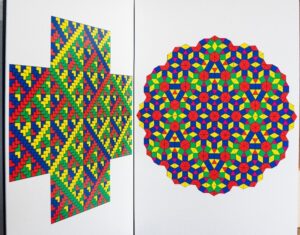Written by Senior lecturer in Mathematics Education, and co-organiser of the Aperiodic tilings exhibition, Charlotte Webb.
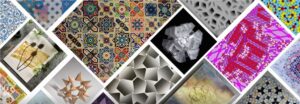
In this post, I will reflect on the Aperiodic tiling exhibition and workshop and offer the reader suggested activities and resources to use at home or in the classroom with learners.
An event inspired by, and in honour of Professor Uwe Grimm
In June 2022, the Open University hosted a collaborative art exhibition and interactive workshop inspired by the life and work of Professor Uwe Grimm, who sadly died in October 2021.
You can visit our online gallery here: Aperiodic tilings online exhibition | School of Mathematics and Statistics (open.ac.uk)
Uwe’s friend and colleague Ian Short wrote the following passage:
Uwe’s research career began in mathematical physics and later moved into mathematical biology, combinatorics and the theory of aperiodic order, which was the mathematical study of the artwork displayed in the exhibition. He was a world leader in aperiodic tilings. Uwe and co-author Michael Baake wrote and edited the beautifully illustrated series of mathematical books Aperiodic Order, which are invaluable resources for researchers in the field. Some of the images from the first text in this series were displayed at the exhibition and are available to view on the online gallery. These same images were used by Uwe to convey the beauty of mathematics to school students and the public in many outreach events.
Two of Uwe’s designs on display at the exhibition
Reflecting on the exhibition and workshop, there were three key features which made this event unique in my view: Collaboration, Creativity and Community.
Collaboration
From the very start this event was collaborative in nature. The planning committee itself consisted of academics from different fields in mathematics and education, each bringing our own perspective and drawing on our experiences. We worked closely together to organise the three strands: a mathematical conference, an Aperiodic tiling inspired exhibition, and an interactive workshop for school children and members of the public.
The exhibition and linked conference were unique in bringing together mathematicians, engineers, artists, musicians, and educators from across the UK and beyond, all with a common interest in Aperiodic tilings and patterns. This resulted in a rich and diverse display of artworks and interactive workshop materials. For example, Liam Taylor-West, an artist-in-residence at the school of mathematics for the University of Bristol, brought musical installations based on aperiodic patterns which students were able to interact with and discover aperiodic wavelengths. Another artist, Natalie Priebe Frank, who describes herself as a mathematician studying self-similar tilings, brought handmade mobiles and ‘Self-similar Self-portraits’, demonstrating her mathematical research in a visual and accessible way.
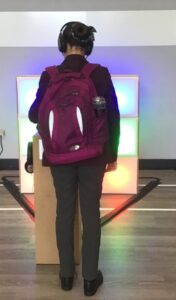
A student visitor interacting with Liam Taylor-West’s light and sound installation: Wavelength.
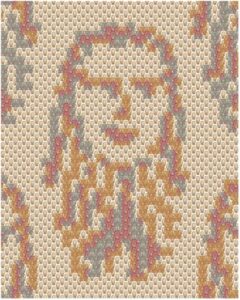
Self-similar self-portrait by Natalie Priebe Frank
Feedback from another of the mathematicians who displayed artwork in the exhibition read: ‘I was greatly impressed by the range and depth of art displayed. For me, this was the largest collection of aperiodic art I have ever seen. For my own exhibit, a collection of items collected over my 25 years involvement in the field of aperiodic research, I received much appreciative feedback. I was so pleased to return from the conference talks to see students playing with the aperiodic tiles I brought, making beautiful patterns.’
Finally, the workshop element allowed collaboration during the exhibition. Adult and school-student visitors worked together to solve geometric puzzles and tiling challenges, and to create collaborative art inspired by Islamic geometry with artist Maryam Smit for our live art wall (pictured below).
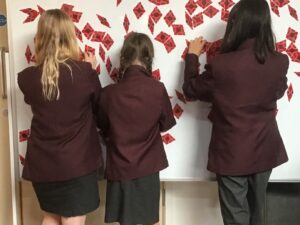
Students working together on an Aperiodic tiling puzzle
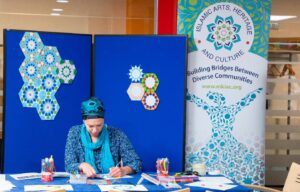
Maryam Smit and the start of our live art wall.
Uwe had inspired cross-curriculum collaboration throughout his career, having moved himself between disciplines. Most recently he had founded the NOVMAT (Novel superior materials based on aperiodic tilings) project, which brought together engineers and mathematicians to explore the potential applications of 3D aperiodic structures, including in acoustics, aerospace, automotive and medical engineering. Earlier in his career he had worked with artists and mathematicians to create outreach resources for the 2009 Royal Society exhibition.
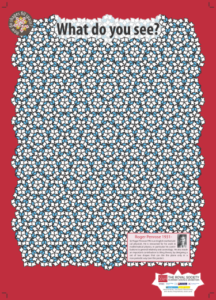
One of the posters created by Uwe and his collaborators for the Royal Society exhibition.
A colleague of Uwe commented that this event was ‘a lovely and fitting memorial to Uwe, an amazing confluence of artists, mathematicians, outreach enthusiasts and their work, and a rare and incredible opportunity for all who could attend’.
Community
In addition to bringing together the already established community of mathematicians, physicists and engineers involved in the research field of aperiodic order, the exhibition brought together a community of Islamic geometric artists, many of whom had never met in person, local school children, OU academics, and the Milton Keynes Islamic Artists Heritage and Culture group (mkiac.org). OU academics had run a workshop at the MKIAC Art in the Park festival earlier this year, inviting members of the public to create tiles for an Islamic geometry inspired tessellation, which was displayed at the exhibition and Art in the Park visitors were invited to view their work on display.
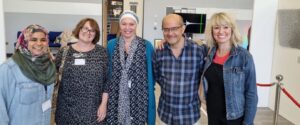
A community of Islamic geometric artists brought together through this event: Samira Mian, Clarissa Grandi, Maryam Smit, Richard Henry, Hasret Brown.
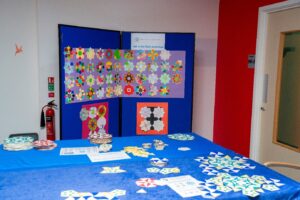
Artwork created at MKIAC’s Art in the Park on display at the exhibition
With around 700 visitors across the two days, this special event allowed two-way engagement between members of the public, artists and academics, where visitors could ask questions and interact with the artwork and puzzles on display. In particular, we worked closely with students at Kents Hill Park secondary school, providing them with learning materials to work on before the exhibition and inviting them to contribute artwork to the exhibition itself. Further details about their involvement can be read below.
One of the many positive outcomes of the event was the impact on the students of visiting a university site. Students commented that they were pleased to have the opportunity to visit the OU, which is situated only a few hundred metres from their school. Many students were surprised that staff and students were on their doorstep, highlighting the importance of this kind of community outreach for schools and colleges.
Creativity
The event was a hive of creativity, as can be seen in the online gallery, but this went beyond just viewing the beautiful works of art displayed in the exhibition. Participants were creative in the way they solved challenges – such as our giant soma cube and tetrahedron puzzle – having to try different approaches, and were able to create their own artwork, working closely with some of our exhibiting artists. Some student visitors commented on how they felt about taking part in the workshop activities: ‘I felt creative, and I thought hard about each activity’, ‘I felt excited, amazed, wowed, challenged when I tried the puzzles.’
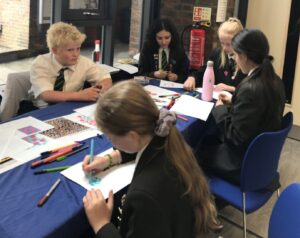
Students working on Isometric patterns with artist Samira Mian
Prior to the exhibition, Kents Hill Park students were asked to complete a Pen-puzzle challenge, based on the famous Penrose tiling, and to create their own mathematical artwork inspired by this tiling using their own choice of colours and decorations. These collaborative pieces of artwork were displayed at the exhibition and are shown below.
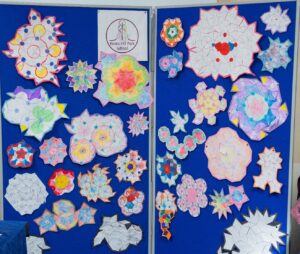
KHP students’ Penrose inspired designs
The students reported feeling: proud, happy, excited, surprised, and confident when seeing their art displayed at the exhibition. They commented on the enjoyment of working together to create mathematical artwork and the communication and teamwork needed to solve the challenging puzzle, putting the tiles together correctly.
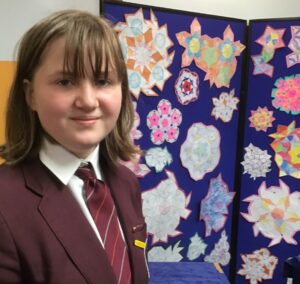
Many students also commented on the unexpected nature of the event and activities, suggesting they had not previously considered the links between mathematics and art. Their teacher commented: ‘Many of our pupils were surprised to learn that the exhibition was all based around maths and this really opened their eyes to maths as a much broader subject than perhaps the curriculum currently allows for. They certainly were given the opportunity to see maths in a very different way. The links between maths and art/music were obvious in the exhibition which allowed the pupils to explore the links between the subjects’.
Join in!
Create your own Penrose inspired artwork like the students of Kents Hill Park School. A PPT resource and printable templates for this activity can be found via the online gallery.
You can also create your own Islamic geometry inspired tessellation, similar to that created by the visitors at Art in the Park (link to resources below).
Share your creations with us on Twitter: @OUMathsStats – we would love to see what you come up with!
Further reading and exploration:
- You can visit our online gallery here: Aperiodic tilings online exhibition | School of Mathematics and Statistics (open.ac.uk)
- In this article for the ATM, I explore how Islamic geometric designs can be used in the classroom: pdf (atm.org.uk)
- You can find further detailed of classroom maths-art activities here: Art in the Mathematics classroom: Islamic Geometry (atm.org.uk)
- You can read another article written by artist and former mathematics teacher Samira Mian, exploring Islamic geometric patterns, here: pdf (atm.org.uk)
- You can read Professor Uwe Grimm’s publications here: Uwe Grimm’s Home Page (open.ac.uk)

